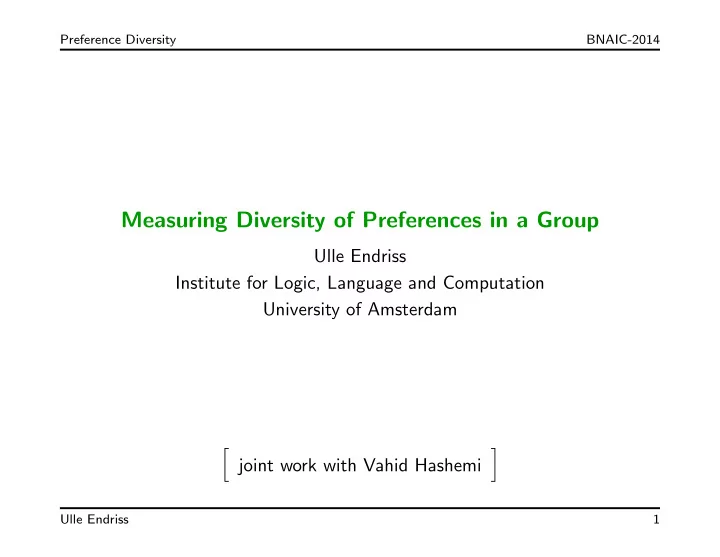

Preference Diversity BNAIC-2014 Measuring Diversity of Preferences in a Group Ulle Endriss Institute for Logic, Language and Computation University of Amsterdam � � joint work with Vahid Hashemi Ulle Endriss 1
Preference Diversity BNAIC-2014 Motivation Preferences are ubiquitous in AI: recommendation, configuration, . . . Preference handling in MAS is particularly interesting. Basic intuition: The less diverse the preferences in a group of agents are, the easier it should be to come to mutually acceptable decisions. V. Hashemi and U. Endriss. Measuring Diversity of Preferences in a Group. Proc. 21st European Conference on Artificial Intelligence (ECAI-2014). Ulle Endriss 2
Preference Diversity BNAIC-2014 Outline • Formal framework, definition of the concept, examples • Theoretical results: axiomatic method • Experimental results: frequency of phenomena modulo diversity Ulle Endriss 3
Preference Diversity BNAIC-2014 Formal Framework Finite set of alternatives X . A preference is a strict linear order on X . L ( X ) is the set of all such preference orders. Each of a finite set of agents N = { 1 , . . . , n } expresses a preference, giving rise to a profile R = ( R 1 , . . . , R n ) ∈ L ( X ) n . We propose the concept of preference diversity index (PDI) to make judgments about which of two profiles we consider more diverse: A PDI is a function ∆ : L ( X ) n → R + ∪ { 0 } , with ∆( R ) = 0 for unanimous profiles R = ( R, . . . , R ) ∈ L ( X ) n . Ulle Endriss 4
Preference Diversity BNAIC-2014 Examples for Specific PDI’s Three options for defining the diversity of a given profile R : • Simple support-based PDI: number of distinct preferences in R . Generalisation: count, for a given k � m , the number of distinct ordered k -tuples of alternatives appearing in R . • Distance-based PDI: measure the distance (e.g., Kendall tau ) between any two preferences in R and then aggregate the values obtained (e.g., by computing their sum or their maximum). • Compromise-based PDI: first aggregate the individual preferences (e.g., using the Borda rule ), then compute the Kendall tau distance of each individual preference to that “compromise”, and finally aggregate (e.g., add) the values obtained. Ulle Endriss 5
Preference Diversity BNAIC-2014 Theoretical Results Adopt the axiomatic method from social choice theory to formulate and explore desirable properties of PDI’s . . . • Weak discernability: only unanimous profiles have diversity 0 • Anonymity (A): order of agents does not matter • Neutrality (N): order of alternatives does not matter • Strong discernability: no two equally diverse profiles (unless for A/N) • Support invariance: equally diverse if { R 1 , . . . , R n } = { R ′ 1 , . . . , R ′ n } • Independence: R � R ′ implies R ⊕ R � R ′ ⊕ R for “new” R Two results: • Proposition: For n > m ! and m > 2 , there can be no PDI that is both support-invariant and strongly discernable . • Proposition: A PDI is weakly discernible, support-invariant, and independent if and only if it is the simple support-based PDI . Ulle Endriss 6
Preference Diversity BNAIC-2014 Experimental Results Setup: • distance-based PDI (Kendall tau, sum) • 50 agents / 5 alternatives / 1M profiles • x -axis: diversity (from 0 to max) Right: • Condorcet winners / cycles • agreement between voting rules • voter satisfaction Bottom: • y -axis: frequency of diversity x • impartial culture vs . real data (AGH) Ulle Endriss 7
Preference Diversity BNAIC-2014 Last Slide We have introduced a formal framework for studying the important concept of diversity of preferences in a group. • General notion of PDI (preference diversity index) • Three proposals for (families) of specific PDI’s • Axioms for “good” PDI’s ( impossibility / characterisation results) • Experimental results: discern real from synthetic data • Experimental results: choice-theoretic effects depend on diversity Many opportunities for future research: • More/better specific PDI’s to use in practice • More/better axioms , more characterisation results • Analytically prove facts about experimentally observed trends • Use PDI’s to structure experimental work in preference handling V. Hashemi and U. Endriss. Measuring Diversity of Preferences in a Group. Proc. 21st European Conference on Artificial Intelligence (ECAI-2014). Ulle Endriss 8
Recommend
More recommend